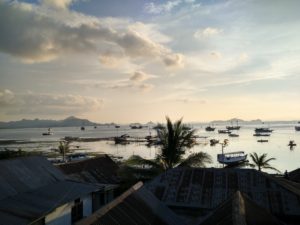Evening comes, leaving the streets of Labuan Bajo covered by the darkness. We, the four interns, have taken this opportunity to explore the town in the cooler air, wandering the bustling streets as bemo – local buses – rattle past. After  calling in to Dive Komodo, a local dive operator, to prepare our equipment for tomorrow’s training dive, we decide to return home top study our diver training manual and to rest from the busy day ahead. But I have an extra task, to write this journal.

Evening in Labuan Bajo
Today was our second day in Labuan Bajo. We’ve all been given a lot of invaluable knowledge from Andy and our mentors, Ichsan and Vidlia, about manta ray biology, ecology and conservation.
Early this morning, we had an interesting event at the office of the Komodo National Park Authority to introduce our program and and ourselves. Andy opened by introducing MantaWatch, while Ichsan and Vidlia explained about the goals of the MantaWatch Internship Program to enhance the knowledge of future Indonesian marine conservationists.
We felt a little ackward at the beginning. For us this was the first time to meet local stakeholders, and we still had no idea what the atmosphere wold be. Then the discussion started to become very dynamic, as many questions stimulated the forum and our interest about current issues in Labuan Bajo.
“Labuan Bajo is a land of blessing, with the Komodo dragon on land, and manta rays in the ocean. Two flagship species that tourists travel around the world to see,” Andy explained.
Goosebumps. We felt that. We just realized that, yes, we had encountered many tourists here in Labuan Bajo, coming from many different countries to see the Komodo dragon and manta rays. The thing that came into our thoughts was, “manta Rays must be a valuable asset to support the welfare of local people and communities in Labuan Bajo.” But then, more discussion and statements followed, and we learned that things are a little more complicated and that we still have much to learn.
Many things opened our eyes. Labuan Bajo is an amazing place for us to learn how successful conservation approaches must consider communities and society. Even though many people are aware about manta rays, their values and urgent need for protection, but somehow other factors must also be considered to protect this species. Waste management and tourism development appear to be two very important issues in Labuan Bajo that must be planned soon. At least, that’s the idea that I got following our meeting with Komodo National Park Authority.
We have 26 days to go, and in the first week of MIP-2016 we believe that we are starting to realise that collaboration and coordination is very important for sustainable conservation. It’s not merely increasing awareness, but also a well-managed action plan which defines the roles, responsibilities and objectives for each stakeholder. A very long journey, but we believe that we are learning a lot that will help us make a good contribution to this task.



